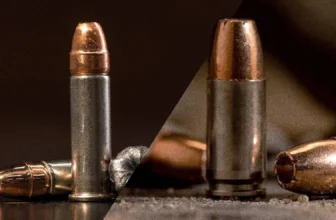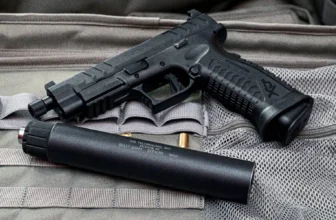Food, gas, housing — it seems like prices are up across the board these days. But the price of ammo is one of the most egregious examples. And it seems like there is no end to the price inflation in sight.
The initial COVID lockdowns triggered a massive run on guns and ammo, so the situation made sense then. But it’s been more than two years now. When can we expect to see prices come down?
It’s a complex question with a lot of factors at work. So to best understand it, let’s take a look at what’s causing the inflated cost of ammo, and whether falling prices are in the cards or not.
Why Is Ammo So Expensive?
The high cost of gun ammo doesn’t have one singular cause. If that were the case, the problem could have been solved by now.
No, ammunition prices are being held aloft by a slate of problems on both national and international levels. Here are only a few of them.
Inflation
You watch the news for more than a few minutes these days without hearing a story about inflation. In May, the inflation rose by 8.6%, the largest jump since 1981.
A lot of the discussion around inflation centers around the cost of food and fuel. But the average ammo price is not immune. Even if there hadn’t been a surge in gun ownership or a supply shortage, we’d still be paying higher ammunition prices just because of inflation.
The War in Ukraine
The ongoing conflict in Europe affects the cost of ammo in the U.S. in two key ways.
The first is that last September, the Biden administration imposed sanctions that effectively banned new imports of Russian firearms and ammunition. While some cheap Russian stock was able to slip through due to a loophole for existing permits, the move slashed the total amount of ammo being imported.
Second, an increasing amount of arms and ammunition are being diverted to the Ukrainian cause. Some manufacturers have already donated millions of rounds to Ukraine in solidarity. Others are devoting large shares of their production capabilities to fulfill government contracts that provide arms for Ukraine.
The longer the conflict drags on, the longer it will contribute to our shortages at home.
Shortages of Raw Materials
Even as manufacturers are trying to bring more factories online and increase production, they’re beset by shortages of the basic materials they need to produce ammo.
The biggest problem is the shortage of copper. Used to create casings and jackets, it’s essential to most ammo production.
Unfortunately, it’s essential to many other industries, as well. Green technology, in particular.
An electric car takes three times the copper to produce as its gas-powered equivalent. And projects that would convert much of the power grid to solar or wind power likewise need copper for energy storage components.
Ammunition manufacturers find themselves competing with tech and green energy companies over a supply of this base metal that is not meeting demand. Efforts are being made to increase copper production, but we can expect to see those dividends in a matter of years, not months.
Will the Price of Ammo Come Back Down?
In the long run, ammo prices will trend down eventually. That said, it might not be until 12-24 months until we start to see those trends.
Yes, manufacturers are indeed doing everything they can to ramp up production. The problem is that building the infrastructure that would make that possible takes time.
It could be months before a lot of the planned new factories come on line. And even then, it would take even more time for all that new stock to be manufactured, sent to distributors, and then shipped out to local shops and retailers.
And that’s assuming a best-case scenario, which doesn’t seem likely. Whenever there’s a spike in COVID cases, manufacturers lose productivity as workers are out sick.
Meanwhile, demand continues to climb, mitigating many of the gains in production capacity. And if it’s not hunters or new gun owners buying up all the available stock, it’s the ammo scalpers. These characters buy up ammo in bulk so that they can resell it to stores at a markup, who then have to pass those increased costs on to their customers.
While all of this is happening, supply chain problems are hampering the industry’s ability to produce domestic ammo and for retailers to bring in imported stock.
So in short, expect prices to continue to rise for the foreseeable future.
So What Can We Do Now?
Realistically, most of us aren’t going to wait until 2023 or beyond to restock our ammo. So what can we do in the interim?
Well, it’s a shame to say, but the simplest thing would be to bite the proverbial bullet. If you insist on buying ammo from your local shops, you might have to pay whatever prices you get out in the wild. Especially for uncommon or in-demand cartridges.
An alternative is to take up handloading. Or if you don’t have the time or aptitude to do it yourself, you could partner with handloading enthusiasts in your area and place informal orders with them. But even this approach is imperfect, as periodic primer shortages can make it impractical.
The best alternative is to order ammunition in bulk. By doing so, you not only get ammo in quantity but shave off some of the retailer’s markup. And with free shipping on bulk orders, you can boost your savings even further.
Smarter Ammo Shopping
The price of ammo will return to normal eventually. But unfortunately, that timeframe is still a matter of months at the best, and a year or more at worst. And for avid shooters, waiting that long to stock up is intolerable.
That’s why you need to invest in an Ammo Prime membership.
With membership, you’ll get an 8% discount and free shipping on every order to help reduce your ammo bill. We’ll also send you priority alerts when new stock arrives, so you’ll be first in line for those hard-to-find calibers. Join now and start saving today.






